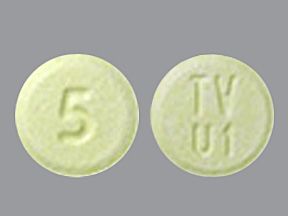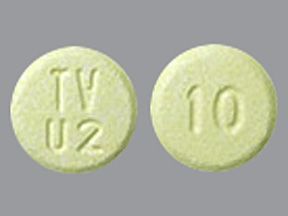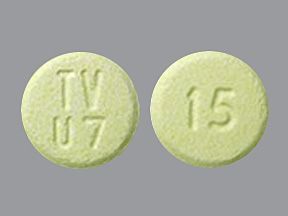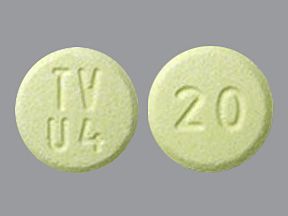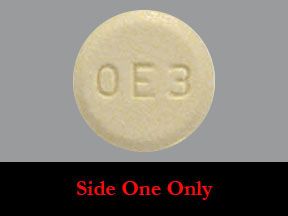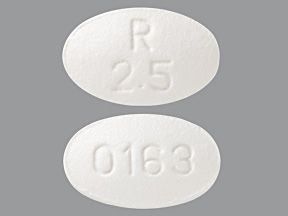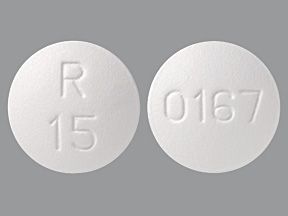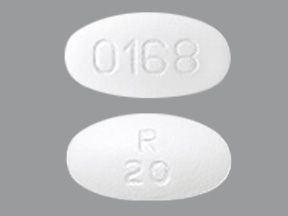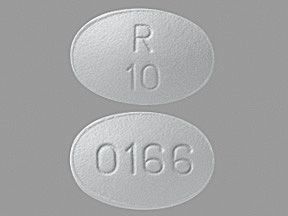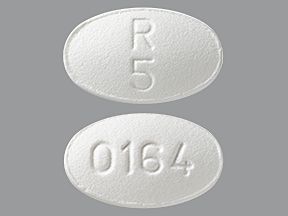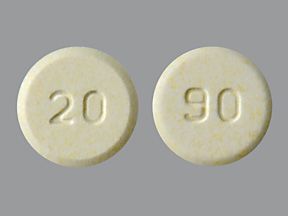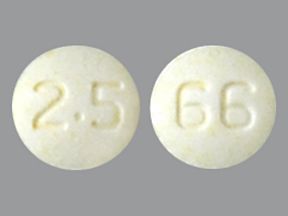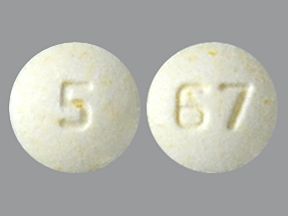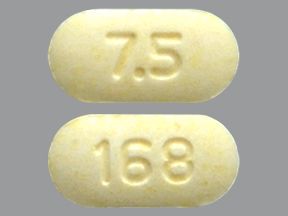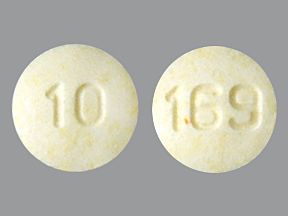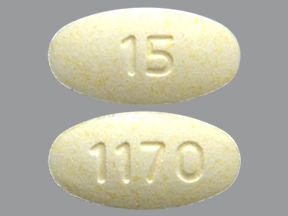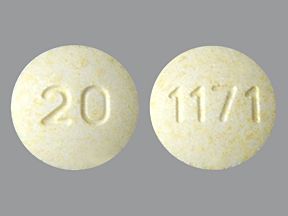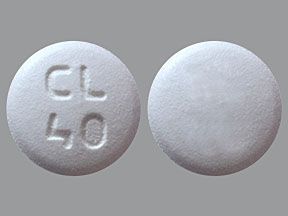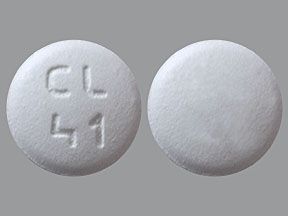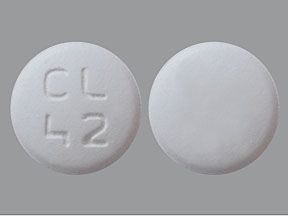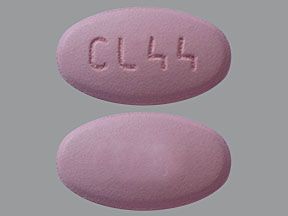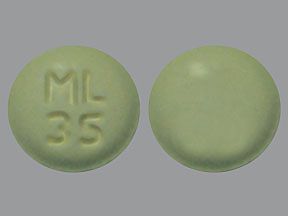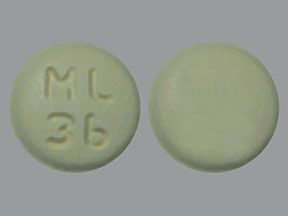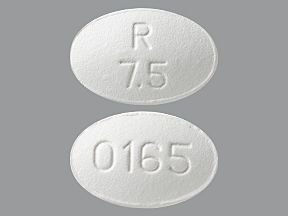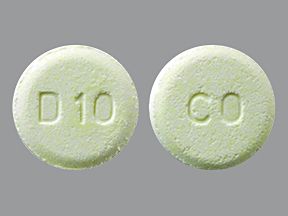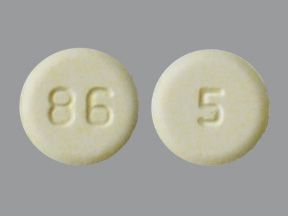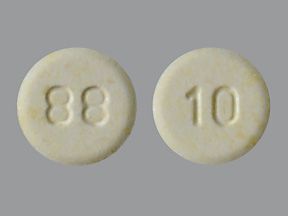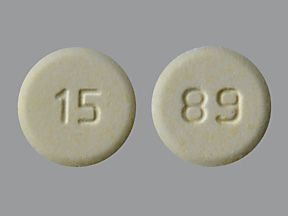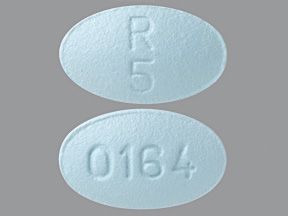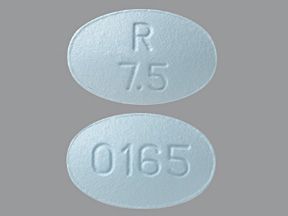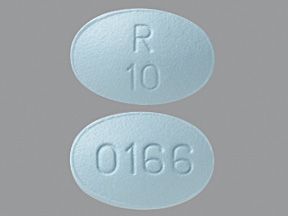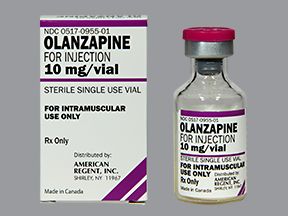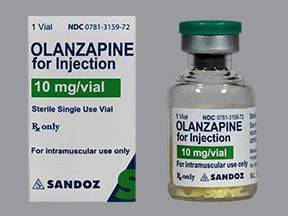Highlights for olanzapine
- Olanzapine oral tablet is available as brand-name drugs and generic drugs. Brand names: Zyprexa, Zyprexa Zydis.
- Olanzapine comes as a regular tablet and a disintegrating tablet. Both are taken by mouth. (The disintegrating tablet will dissolve on your tongue.) Olanzapine also comes as an injectable solution given only by a healthcare professional.
- Olanzapine is used to treat schizophrenia and certain types of bipolar disorders. It’s also used in combination with an antidepressant to treat depression that can’t be controlled with other drugs.
This drug has a boxed warning. These are the most serious warnings from the Food and Drug Administration (FDA). Black box warnings alert doctors and patients about drug effects that may be dangerous.
- Increased death and heart-related side effects in seniors with dementia-related psychosis: Olanzapine isn’t approved for treating psychosis that’s related to dementia. There is an increased risk of death in seniors (ages 65 years or older) with this condition who take this drug. Most deaths are caused by heart problems such as heart failure, or infectious conditions such as pneumonia.
Other warnings
- Neuroleptic malignant syndrome warning: Olanzapine can cause a condition called neuroleptic malignant syndrome. This rare but very serious disease can cause death and must be treated in a hospital. Call 911 right away if you become very ill with symptoms such as:
- high fever
- excessive sweating
- rigid muscles
- confusion
- changes in breathing, heartbeat, or blood pressure
- DRESS warning: Olanzapine can cause a condition called drug reaction with eosinophilia and systemic symptoms (DRESS). This condition can be serious and can sometimes cause death. Stop taking this drug and call your doctor right away if you have any of the following symptoms:
- rash
- fever
- swollen glands
- Body temperature problems warning: Olanzapine can cause you to become very hot. This can occur when you exercise a lot or stay in an area where the temperature is very high. If you feel hot, be sure to drink water to avoid dehydration (low fluid levels). Call your doctor right away if you become very ill with any of these symptoms:
- sweating too much or not at all
- dry mouth
- feeling very hot
- feeling thirsty
- not being able to produce urine
- Anticholinergic effects warning: Olanzapine can cause effects similar to those caused by drugs called anticholinergics. This can raise your risk of dementia, or cause certain medical conditions to worsen. Call your doctor if you have any of the following symptoms:
- trouble urinating
- dry mouth
- fast heartbeat
Olanzapine is a prescription drug. It comes in the form of a tablet and a disintegrating tablet. (The disintegrating tablet will dissolve on your tongue.) Both forms are taken by mouth.
An injectable form is also available. This form is given only by a healthcare professional.
Olanzapine oral tablets are available as the brand-name drugs Zyprexa (oral tablet) and Zyprexa Zydis (disintegrating tablet). They’re also available as generic drugs. Generic drugs usually cost less than the brand-name versions. In some cases, they may not be available in every strength or form as the brand-name drugs.
Olanzapine may be used as part of a combination therapy. This means you may need to take it with other medications, such as lithium, valproate, or fluoxetine.
Why it’s used
Olanzapine is used to treat schizophrenia and bipolar I disorder. It’s also used with fluoxetine to treat other conditions. These include depression caused by bipolar I disorder as well as depression that can’t be controlled with other drugs.
How it works
Olanzapine belongs to a class of drugs called atypical antipsychotics. A class of drugs is a group of medications that work in a similar way. These drugs are often used to treat similar conditions.
It’s not known exactly how olanzapine works. It’s thought that it may help to regulate the amount of certain chemicals (dopamine and serotonin) in your brain to help control your mood.
Olanzapine oral tablet may cause drowsiness. Don’t drive, use machinery, or do dangerous activities until you know how this drug affects you. This drug can also cause other side effects.
More common side effects
The adult side effects for olanzapine are slightly different from the side effects for children.
Adult side effects can include:
- orthostatic hypotension (low blood pressure upon standing after lying down or sitting)
- lack of energy
- dry mouth
- increased appetite
- tiredness
- tremor (shakes)
- constipation (hard or infrequent stools)
- dizziness
- restlessness
- changes in behavior that might be considered offensive to others
- weight gain
Children and adolescent side effects can include the above, plus:
- headache
- pain in the abdomen (stomach area)
- pain in the arms and legs
If these effects are mild, they may go away within a few days or a couple of weeks. If they’re more severe or don’t go away, talk with your doctor or pharmacist.
Serious side effects
Call your doctor right away if you have serious side effects. Call 911 if your symptoms feel life-threatening or if you think you’re having a medical emergency. Serious side effects and their symptoms can include the following:
- Stroke or mini strokes (transient ischemic attacks) or death. These can occur in seniors (ages 65 years and older) who have confusion, memory loss, and dementia-related psychosis. Symptoms of a stroke can include:
- confusion
- trouble speaking or slurred speech
- numbness on one side of the body
- weakness
- Drug reaction with eosinophilia and systemic symptoms (DRESS). Symptoms can include:
- fever
- rash or peeling skin
- enlarged lymph nodes
- Hyperglycemia (high blood sugar). Symptoms can include:
- frequent urination
- increased thirst
- fruity-smelling breath
- blurry vision
- increased hunger
- feeling weak or tired
- confusion
- High cholesterol and triglycerides. You may not have any symptoms, but your doctor will check your cholesterol levels before and during treatment with olanzapine.
- Low levels of white blood cells or neutrophils. This can cause infections, with symptoms such as:
- fever
- sore throat
- Neuroleptic malignant syndrome. Symptoms can include:
- high fever
- excessive sweating
- rigid muscles
- confusion
- changes in your breathing, heartbeat, or blood pressure
- Tardive dyskinesia (uncontrolled body movements). This condition can occur during or after treatment with this drug. It may go away after you stop treatment, or it may continue (be permanent). Symptoms can include:
- uncontrolled movements in your face and tongue, or other parts of the body
- Orthostatic hypotension (decreased blood pressure when you change positions, especially when you stand up after sitting or lying down). This can cause falls or fainting. Symptoms can include:
- dizziness
- fast or slow heartbeat
- feeling faint
- Seizures
- Trouble swallowing (this can cause food or fluids to get into your lungs)
- Problems with control of body temperature. Symptoms can include:
- sweating too much or not at all
- dry mouth
- feeling very hot
- feeling thirsty
- not being able to produce urine
- Falls that can cause fractures or other injuries. Olanzapine can cause you to be tired and have some shakiness when moving, which could lead to a fall.
Disclaimer: Our goal is to provide you with the most relevant and current information. However, because drugs affect each person differently, we cannot guarantee that this information includes all possible side effects. This information is not a substitute for medical advice. Always discuss possible side effects with a healthcare professional who knows your medical history.
Olanzapine oral tablet can interact with other medications, vitamins, or herbs you may be taking. An interaction is when a substance changes the way a drug works. This can be harmful or prevent the drug from working well.
To help avoid interactions, your doctor should manage all of your medications carefully. Be sure to tell your doctor about all medications, vitamins, or herbs you’re taking. To find out how this drug might interact with something else you’re taking, talk with your doctor or pharmacist.
Examples of drugs that can cause interactions with olanzapine are listed below.
Interactions that increase your risk of side effects
- Increased side effects from olanzapine: Taking olanzapine with certain medications raises your risk of side effects from olanzapine. This is because the amount of olanzapine in your body is increased. Examples of these drugs include:
- Fluvoxamine. Increased side effects can include tremor (shakes). To avoid this problem, your doctor may lower your olanzapine dosage.
- Other increased side effects: Taking olanzapine with certain medications raises your risk of side effects that both olanzapine and these other drugs can cause. Examples of these drugs include:
Benzodiazepines, such as diazepam. Increased side effects can include orthostatic hypotension, drowsiness, tiredness, and dizziness. Your doctor will monitor you closely during therapy.
Blood pressure medications. These include angiotensin II receptor blockers (ARBs), such as candesartan, irbesartan, or losartan. They also include angiotensin-converting enzyme (ACE) inhibitors, such as benazepril, captopril, or enalapril. Increased side effects can include a dangerous decrease in your blood pressure. To help avoid this, your doctor may decrease your olanzapine dosage.
Anticholinergics, such as atropine or dicyclomine. Increased side effects can include constipation, trouble urinating, and falls. Your doctor will monitor you closely during therapy.
Interactions that can make your drugs less effective
- When olanzapine is less effective: When olanzapine is used with certain drugs, it may not work as well to treat your condition. This is because the amount of olanzapine in your body may be decreased. Examples of these drugs include:
- Anticonvulsants, such as phenytoin or carbamazepine. Your doctor may lower your dosage of these drugs.
- Rifampin. Your doctor may increase your dosage of olanzapine or lower your dosage of rifampin.
- When other drugs are less effective: When certain drugs are used with olanzapine, they may not work as well. This is because the amount of these drugs in your body may be decreased. Examples of these drugs include:
- Levodopa and dopamine agonists, such as pramipexole and ropinirole. If you’re taking levodopa or dopamine agonists for Parkinson’s disease, your doctor may stop your olanzapine treatment.
Disclaimer: Our goal is to provide you with the most relevant and current information. However, because drugs interact differently in each person, we cannot guarantee that this information includes all possible interactions. This information is not a substitute for medical advice. Always speak with your healthcare professional about possible interactions with all prescription drugs, vitamins, herbs and supplements, and over-the-counter drugs that you are taking.
This drug comes with several warnings.
Allergy warning
Olanzapine can cause a severe allergic reaction. Symptoms can include:
- trouble breathing
- swelling of your throat or tongue
- itching
- hives
If you develop these symptoms, call 911 or go to the nearest emergency room.
Don’t take this drug again if you’ve ever had an allergic reaction to it. Taking it again could be fatal (cause death).
Alcohol interaction warning
Avoid the use of drinks that contain alcohol while taking olanzapine. Drinking alcohol while taking olanzapine raises your risk of orthostatic hypotension. When this occurs, your blood pressure drops too low after you stand up after sitting or lying down.
Drinking alcohol can also increase the drowsiness caused by olanzapine. If you drink alcohol, talk with your doctor about whether this drug is safe for you.
Warnings for people with certain health conditions
For people with Alzheimer’s disease: Olanzapine isn’t approved to treat dementia-related psychosis or Alzheimer’s disease. Olanzapine raises the risk of death in seniors (ages 65 years or older) with dementia-related psychosis. Most of these deaths are caused by heart problems such as heart failure, or infectious conditions such as pneumonia.
For people with seizures: Olanzapine can cause seizures. Tell your doctor if you have a history of seizures or epilepsy.
For people with diabetes or high sugar levels: Olanzapine can increase your blood sugar levels. Your doctor should check your blood sugar levels before and during treatment with this drug. They may need to adjust the dosage of any diabetes medications you take.
While you take this drug, watch for symptoms of high blood sugar. These can include feeling very thirsty, needing to urinate often, having an increased appetite, or feeling weak. If you have these symptoms, check your fasting blood sugar level and call your doctor.
For people with heart problems: Olanzapine can cause a sudden drop in blood pressure. If you have certain heart problems, talk with your doctor about whether this drug is safe for you. These problems include heart disease, a history of heart attack or stroke, heart failure, or problems with blood flow through the heart. They also include any conditions that may get worse if your blood pressure drops too low.
For people with high cholesterol: Olanzapine can cause high cholesterol levels. Very large increases in cholesterol can occur with no symptoms. Be sure to have your or your child’s cholesterol levels checked when your doctor suggests it.
For people with blood problems: Olanzapine can cause low levels of white blood cells, or neutrophils. These low levels raise your risk of infections. If you have a history of blood problems or are on other drugs that can lower levels of these blood cells, your doctor should check your blood often during the first few months of treatment with this drug. They should also monitor you for fever or any signs of infection. Your doctor might have to stop your treatment with olanzapine until your blood cell levels return to normal.
For people with liver problems: If you have liver problems or a history of liver disease, you may not be able to clear this drug from your body well. This may increase the levels of olanzapine in your body and cause more side effects. This drug can also damage your liver.
For people with enlarged prostate: In men, olanzapine may worsen symptoms of an enlarged prostate or benign prostatic hyperplasia (BPH). If you have an enlarged prostate, talk with your doctor about whether this drug is safe for you.
For people with narrow-angle glaucoma: Olanzapine may worsen your glaucoma symptoms. If you have narrow-angle glaucoma, talk with your doctor about whether this drug is safe for you.
For people with bowel problems: Olanzapine may worsen any bowel obstruction or blockages. If you have any bowel problems, talk with your doctor about whether this drug is safe for you.
Warnings for other groups
For pregnant women: Olanzapine is a category C pregnancy drug. That means two things:
- Research in animals has shown adverse effects to the fetus when the mother takes the drug.
- There haven’t been enough studies done in humans to be certain how the drug might affect the fetus.
Talk with your doctor if you’re pregnant or planning to become pregnant. This drug should only be used if the potential benefit justifies the potential risk.
If you become pregnant while taking this drug, call your doctor right away.
For women who are breastfeeding: Olanzapine passes into breast milk and may cause side effects in a child who is breastfed. You should not breastfeed if you’re using olanzapine. Talk with your doctor if you breastfeed your child. You should decide whether to stop breastfeeding or stop taking this medication.
For seniors: The kidneys of older adults may not work as well as they used to. This can cause your body to process drugs more slowly. As a result, a higher amount of a drug stays in your body for a longer time. This raises your risk of side effects.
For children:
- Schizophrenia: It hasn’t been established that this drug is safe and effective for treatment of schizophrenia in children younger than 13 years.
- Bipolar I disorder: It hasn’t been established that this drug is safe and effective for treatment of bipolar I disorder in children younger than 13 years.
- Treatment-resistant depression: It hasn’t been established that this drug is safe and effective for use with fluoxetine in the treatment of treatment-resistant depression in children younger than 18 years.
- Bipolar depression: It hasn’t been established that this drug is safe and effective for use with fluoxetine in the treatment of bipolar depression in children younger than 10 years.
All possible dosages and drug forms may not be included here. Your dosage, drug form, and how often you take the drug will depend on:
- your age
- the condition being treated
- how severe your condition is
- other medical conditions you have
- how you react to the first dose
Drug forms and strengths
Generic: Olanzapine
- Form: oral tablet
- Strengths: 2.5 mg, 5 mg, 7.5 mg, 10 mg, 15 mg, 20 mg
- Form: oral disintegrating tablet
- Strengths: 5 mg, 10 mg, 15 mg, 20 mg
Brand: Zyprexa
- Form: oral tablet
- Strengths: 2.5 mg, 5 mg, 7.5 mg, 10 mg, 15 mg, 20 mg
Brand: Zyprexa Zydis
- Form: oral disintegrating tablet
- Strengths: 5 mg, 10 mg, 15 mg, 20 mg
Dosage for schizophrenia
Adult dosage (ages 18 years and older)
- Typical starting dosage: 5–10 mg once per day.
- Dosage increases: If you’re started on a daily dose of 5 mg, within several days, your doctor may increase your dosage to a daily dose of 10 mg. Any further dosage changes will likely occur after at least 1 week of treatment. Your dosage will likely be changed by 5 mg at a time.
- Maximum dosage: 20 mg per day.
Child dosage (ages 13–17 years)
- Typical starting dosage: 2.5–5 mg once per day.
- Dosage increases: Your doctor may increase your dosage to 10 mg daily. Your dosage will likely be changed by 2.5 mg or 5 mg at a time.
- Maximum dosage: 20 mg per day.
Child dosage (ages 0–12 years)
It hasn’t been confirmed that olanzapine is safe and effective for the treatment of schizophrenia in people younger than 13 years.
Dosage for bipolar I disorder
Adult dosage (ages 18 years and older)
Use of olanzapine alone:
- Typical starting dosage: 10–15 mg once per day.
- Dosage increases: Dosage changes are typically not done more often than every 24 hours. They’re typically changed by 5 mg at a time.
- Maximum dosage: 20 mg.
Use in combination with lithium or valproate:
- Typical starting dosage: 10 mg olanzapine once per day.
- Maximum dosage: 20 mg olanzapine.
Child dosage (ages 13–17 years)
- Typical starting dosage: 2.5–5 mg once per day.
- Dosage increases: Your doctor may increase your child’s dosage to 10 mg daily. Your child’s dosage will likely be changed by 2.5 mg or 5 mg at a time.
- Maximum dosage: 20 mg per day.
Child dosage (ages 0–12 years)
It hasn’t been confirmed that olanzapine is safe and effective for the treatment of bipolar I disorder in people younger than 13 years.
Dosage for treatment-resistant depression
Note: Olanzapine must be used together with fluoxetine for this condition.
Adult dosage (ages 18 years and older)
- Typical starting dosage: 5 mg olanzapine and 20 mg fluoxetine, taken once per day in the evening.
- Dosage increases: Your doctor can adjust your dosage based on how well this drug works for you. The dosage range is 5–20 mg olanzapine used with 20–50 mg fluoxetine.
- Maximum dosage: 18 mg olanzapine with 75 mg fluoxetine.
Child dosage (ages 0–17 years)
It hasn’t been confirmed that olanzapine is safe and effective for the treatment of treatment-resistant depression in people younger than 18 years.
Senior dosage (ages 65 years and older)
- Typical starting dosage: 2.5–5 mg olanzapine with 20 mg fluoxetine per day.
- Dosage increases: Your doctor may carefully increase your dosage as needed.
Dosage for bipolar depression
Note: Olanzapine must be used together with fluoxetine for this condition.
Adult dosage (ages 18 years and older)
- Typical starting dosage: 5 mg olanzapine and 20 mg fluoxetine, taken once per day in the evening.
- Dosage increases: Your doctor can adjust your dosage based on how well this drug works for you. The dosage range is 5–12.5 mg olanzapine used with 20–50 mg fluoxetine.
- Maximum dosage: 18 mg olanzapine with 75 mg fluoxetine.
Child dosage (ages 10–17 years)
- Typical starting dosage: 2.5 mg olanzapine and 20 mg fluoxetine, taken once per day in the evening.
- Dosage increases: Your doctor may change your child’s dosage based on how well this drug works for your child.
- Maximum dosage: 12 mg olanzapine with 50 mg fluoxetine.
Child dosage (ages 0–9 years)
It hasn’t been confirmed that olanzapine is safe and effective for the treatment of bipolar depression in people younger than 10 years.
Senior dosage (ages 65 years and older)
- Typical starting dosage: 2.5–5 mg olanzapine with 20 mg fluoxetine per day.
- Dosage increases: Your doctor may carefully increase your dosage as needed.
Disclaimer: Our goal is to provide you with the most relevant and current information. However, because drugs affect each person differently, we cannot guarantee that this list includes all possible dosages. This information is not a substitute for medical advice. Always speak with your doctor or pharmacist about dosages that are right for you.
Olanzapine oral tablet is used for long-term treatment of schizophrenia, and short-term or long-term treatment of bipolar I disorder. It’s used with lithium or valproate for long-term treatment of bipolar I disorder. It’s also used with fluoxetine for long-term treatment of treatment-resistant depression or bipolar depression.
This drug comes with serious risks if you don’t take it as prescribed.
If you stop taking the drug suddenly or don’t take it at all: Your symptoms won’t be controlled. This could cause serious complications. These include suicidal thoughts or behaviors, or thoughts of hurting others.
If you miss doses or don’t take the drug on schedule: Your medication may not work as well or may stop working completely. For this drug to work well, a certain amount needs to be in your body at all times.
If you take too much: You could have dangerous levels of the drug in your body. Symptoms of an overdose of this drug can include:
- agitation or aggressiveness
- rapid heartbeat
- uncontrollable muscle movements
- extreme drowsiness
- slurred speech
- coma
If you think you’ve taken too much of this drug, call your doctor or seek guidance from the American Association of Poison Control Centers at 1-800-222-1222 or through their online tool. But if your symptoms are severe, call 911 or go to the nearest emergency room right away.
What to do if you miss a dose: Take your dose as soon as you remember. But if you remember just a few hours before your next scheduled dose, take only one dose. Never try to catch up by taking two doses at once. This could result in dangerous side effects.
How to tell if the drug is working: You should have decreased symptoms of schizophrenia, bipolar I disorder, bipolar depression, or treatment-resistant depression.
Keep these considerations in mind if your doctor prescribes olanzapine for you.
General
- You can take olanzapine with or without food.
- Take olanzapine at the time(s) recommended by your doctor.
- You can cut or crush the tablet.
Storage
- Store olanzapine at room temperature between 68°F and 77°F (20°C and 25°C).
- Keep this drug away from light.
- Don’t store this medication in moist or damp areas, such as bathrooms.
Refills
A prescription for this medication is not refillable. You or your pharmacy will have to contact your doctor for a new prescription if you need this medication refilled.
Travel
When traveling with your medication:
- Always carry your medication with you. When flying, never put it into a checked bag. Keep it in your carry-on bag.
- Don’t worry about airport X-ray machines. They can’t harm your medication.
- You may need to show airport staff the pharmacy label for your medication. Always carry the original prescription-labeled container with you.
- Don’t put this medication in your car’s glove compartment or leave it in the car. Be sure to avoid doing this when the weather is very hot or very cold.
Self-management
Tips for taking the orally disintegrating tablets (Zyprexa Zydis):
- Be sure that your hands are dry.
- Open the sachet and peel back the foil on the blister. Don’t push the tablet through the foil.
- As soon as you open the blister, remove the tablet and put it into your mouth.
- The tablet will dissolve quickly in your saliva. This will help you swallow it easily, with or without drinking liquid.
Clinical monitoring
You and your doctor should monitor certain health issues during your treatment. This can help make sure you stay safe while you take olanzapine. These issues include:
- Blood sugar level: Your blood sugar level should be checked before treatment and from time to time during treatment with this drug. This will help make sure your levels are within the range your doctor feels is best for you. Your doctor may ask you to check your blood sugar level at home using a blood glucose meter. Your doctor will tell you where to get this device and how to use it. Your doctor may also have you write down your home blood sugar testing results. Based on your results, your doctor may change the dosage of any diabetes medication you take.
- Cholesterol levels: Your doctor should check these levels before treatment and from time to time during treatment with this drug. This will help make sure your levels are within the range your doctor feels is best for you.
- Weight: Your doctor should check your weight from time to time during your treatment.
- Liver function: Your doctor may do blood tests before you start taking this drug to check how well your liver is working. These tests will help make sure this drug is safe for you. Your doctor may also check your liver function throughout your treatment to make sure this drug isn’t causing liver damage.
- Mood: Pay close attention to sudden changes in mood, behaviors, thoughts, or feelings. Watch for any suicidal thoughts or actions. If you notice any unusual changes, call your doctor right away.
- Movement disorders: Call your doctor if you have any body movements that you can’t control. This may be a sign of tardive dyskinesia.
Availability
Not every pharmacy stocks this drug. When filling your prescription, be sure to call ahead to make sure your pharmacy carries it.
Hidden costs
You may need to have blood tests or other tests during your treatment with olanzapine. The cost of these tests will depend on your insurance coverage.
Prior authorization
Many insurance companies require a prior authorization for this drug. This means your doctor will need to get approval from your insurance company before your insurance company will pay for the prescription.
There are other drugs available to treat your condition. Some may be better suited for you than others. Talk with your doctor about other drug options that may work for you.
Disclaimer: Healthline has made every effort to make certain that all information is factually correct, comprehensive, and up-to-date. However, this article should not be used as a substitute for the knowledge and expertise of a licensed healthcare professional. You should always consult your doctor or other healthcare professional before taking any medication. The drug information contained herein is subject to change and is not intended to cover all possible uses, directions, precautions, warnings, drug interactions, allergic reactions, or adverse effects. The absence of warnings or other information for a given drug does not indicate that the drug or drug combination is safe, effective, or appropriate for all patients or all specific uses.

